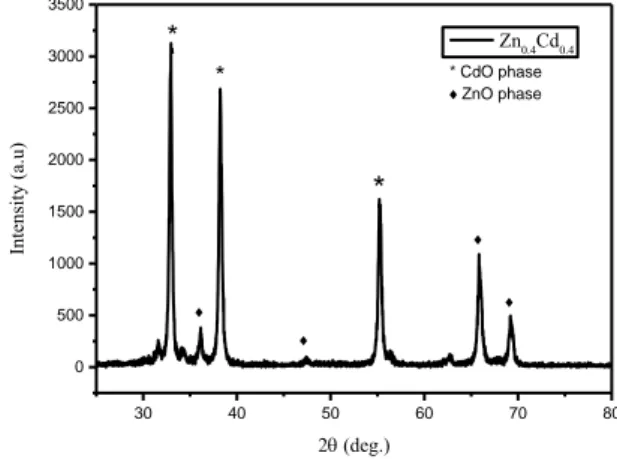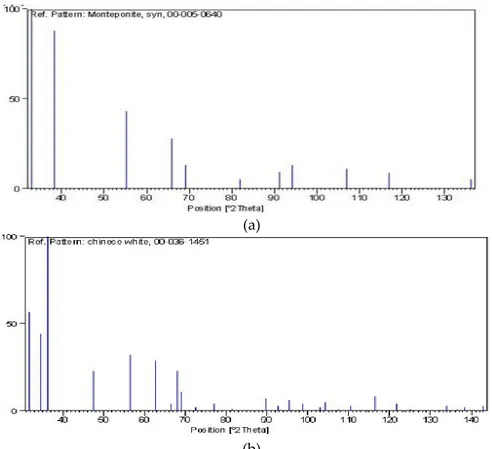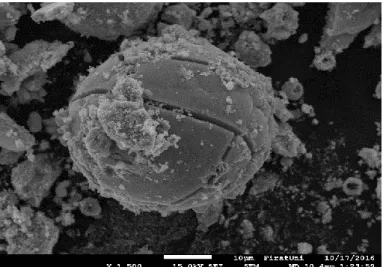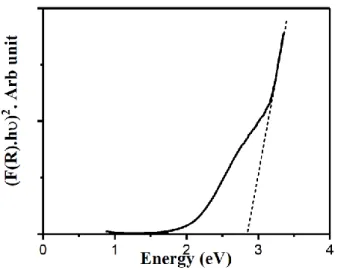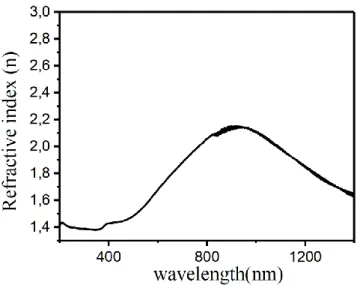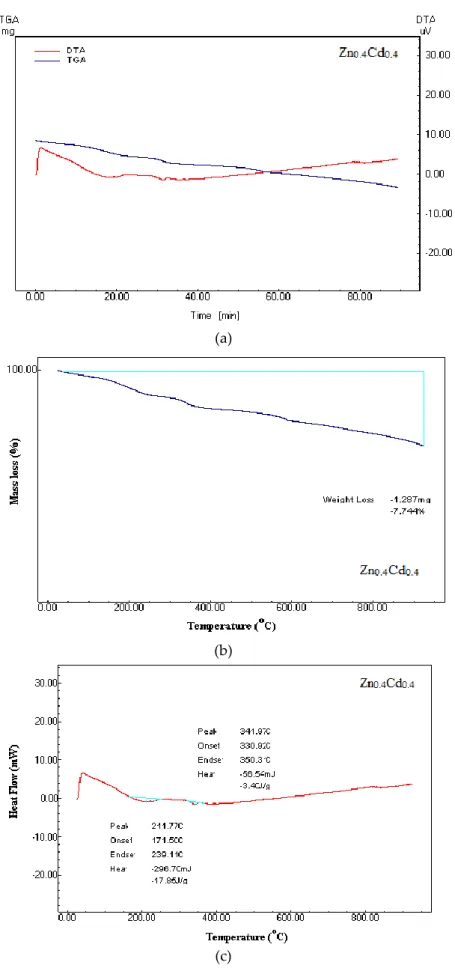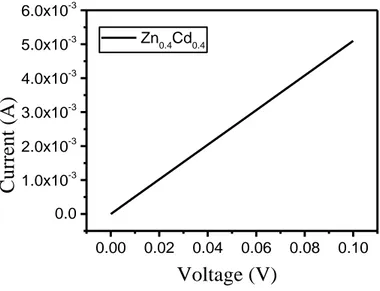Zn0.4Cd0.4 COMPOSITEFABRICATION AND CHARACTERIZATION
1İskender ÖZKUL, 2 Safiye Jameel BIRO
1Mersin University, Department of Mechanical Engineering, Campus, Yenisehir, Mersin, TURKEY 2Firat University, Department of Physic. Elazig, TURKEY
1iskender@mersin.edu.tr, 2safiyejamil@gmail.com
(Geliş/Received: 16.08.2017; Kabul/Accepted in Revised Form: 12.01.2018)
ABSTRACT: ZnO-CdO composite was prepared with hydrothermal method. The structural,
morphological, optical, and electrical properties of the nanocomposite have been carried out using X-ray diffraction (XRD), FTIR, scanning electron microscopy (SEM), UV-VIS-NIR spectrophotometer, and two probe, respectively. TG-DTA analysis was done to determine the thermal stability. The compositional analysis was done by EDX. The band gap of the composite were found to be 2.84 eV.
Key Words: Hydrothermal method, Optical band gap, TG-DTA, Zinc oxide.
Zn0.4Cd0.4 Kompozit Malzemesinin Üretilmesi ve Karakterizasyonu
ÖZ: ZnO-CdO kompoziti hidrotermal yöntemle hazırlandı. Nanokompozitin yapısal, morfolojik, optik
ve elektriksel özellikleri X-ışını kırınımı (XRD), FTIR, taramalı elektron mikroskobu (SEM), UV-VIS-NIR spektrofotometre ve iki prob yöntemi kullanılarak gerçekleştirilmiştir. Termal kararlılığı belirlemek için TG-DTA analizi yapıldı. Bileşim analizi EDX ile yapıldı. Kompozitin optik bant aralığı, Zn prekürsörünün içeriğinin arttırılması ile birlikte sırasıyla 2.84 eV olarak bulunmuştur.
Anahtar Kelimeler: Hidrotermal metod, Optik bant aralığı, TG-DTA, Çinko oksit.
INTRODUCTION
The nano-technology has an importance place in terms of various application. It was developed almost all field in industry. Especially in electronic components it found wide range application area. The material science also has great interest for nano-technology especially developing electronic components.
In general, most oxides are good insulators, but some metal oxides for example CuO and Cu2O,
behave as semiconductors. Due to the less understanding of oxide semiconductors and their growth related processes, there are not many applications of these semiconductor oxides today. Zinc oxide (ZnO) is one exception, which has found application as a transducer, in solar cells and biomedical applications. However, after the discovery of superconductivity in many oxides of copper, the situation has changed, lanthanum copper oxide (La2CuO4) is the first so-called high-Tc superconductor,
discovered by Muller and Bednorz is based on the semiconductor (Müller et al., 1987). Lanthanum copper oxide has a bandgap of about 2 eV. Charge carriers in form of holes are created into La2CuO4 by
replacing divalent barium (Ba) or strontium (Sr) with trivalent lanthanum (La) or when an excess of oxygen is present. When sufficient carriers are available the semiconductor exhibits properties of superconducting metal (Gao et al., 1994; Brus, 1998; Xia et al., 2003; Wang et al., 2008; Yu and Cardona, 2010).
Among other metal oxides CdO, CuO, SnO2 and In2O3 have attracted significant attention for wide
n-type semiconductor material for optoelectronic devices. But the main issue for CdO thin films is low band gap for wider applications. By alloying with ZnO with CdO, the band gap of composite can be red-shifted to blue, or even green light spectra range. Moreover, the incorporation of Cd into ZnO is very useful for the fabrication of ZnO/Zn1−xCdxO heterojunction and super lattice, which is the key element in ZnO-based light emitters and detectors (Wang and Zhu, 2004; Shan, et al., 2006; Kim et al., 2007). ZnO-CdO composites have been prepared such as nanowires (Shan, Liu et al., 2006), hollow micro-nanospheres (Li et al., 2008), nanorods (Wang et al., 2005) previously. The aim of this work is to produce zinc oxide semiconductor based composite material and investigate the optical, structural and electrical properties of oxide composite. In order to conduct experiments the analytical graded chemicals hydrothermally synthesized and composite calcined. Physical and chemical data were obtained by analysing the sample characterization by different methods.
THE EXPERIMENTAL PROCEDURE Material
CdO and ZnO have great effect on optoelectronic applications (Margan and Haghighi, 2018). In our experiment, we have used Zinc nitrate hexahydrate Zn(NO3)2.6H2O (Carlo Erba, Analytical grade) and
Cadmium nitrate tetrahydrate Cd(NO3)2.4H2O (Carlo Erba, Analytical grade). Both chemicals were used
to consist ZnO–CdO. Zinc dioxide is ecofriendly material used as semicoductor photocatalyst which is easily available with reasonable costs and competitive optoelectronic properties (Kołodziejczak-Radzimska and Jesionowski, 2014; Margan and Haghighi, 2018). Cadmium oxide is also semiconductor which known as n-type, uses various in optoelectronic applications (Ueda et al., 1998; Margan and Haghighi, 2018).
Method and Characterization
In this study the hydrothermal synthesis were used in experiments. In hydrothermal technique crystallization from the aqueous solution at high temperature and pressure takes place. This provide us an environmental friendly method for synthesis. The water is being used as solvent and its polarity can be controlled at hydrothermal conditions.
Zinc nitrate hexahydrate Zn(NO3)2.6H2O and Cadmium nitrate tetrahydrate Cd(NO3)2.4H2O were
used as a precursor materials. Zinc nitrate hexahydrate 0.5M was dissolved in 8ml distilled water and 32ml ethylene glycol. Separately cadmium nitrate 0.8M was dissolved in 8ml distilled water and 32ml ethylene glycol. Both the zinc and cadmium solutions were mixed together in volume ratio (40ml:40ml) and so the total volume of solution was 80ml. The final solution was transferred to autoclave and heated at 150 ℃ for 10 hours. After the autoclave, the obtained powder was filtered and washed several times with distilled water. Then the powder was dried at 60 ℃ for 24 hours. Finally the powder sample was calcined at 450 ℃. The preparation of the process has been depicted in Fig. 1.
The crystal phase of the prepared films was investigated using Rigaku-Ultima-IV X-ray diffractometer, utilizing Cu Kα radiation (λ = 0.15406 nm) operated at 40 kV, 30 mA. FTIR spectroscopy analysis was done for compositional analysis (Thermo Scientific iS5). The optical spectra were measured by UV-VIS-NIR spectrophotometer (Shimadzu -3600PC). JEOL JSM-7001F scanning electron microscopy (SEM) were employed to study the morphology of the films. Thermal analysis was done for determine the weight loss of the samples, quality of the product and phase transitions from room temperature to high temperature by TG-DTA measurement device. During the TG-DTA measurements, the mass loss and phase transition temperatures of the sample were determined at room temperature and 900 °C at a heating rate of 10 °C/min.
Figure 1. Schematic display of steps to synthesis ZnO-CdO composite by hydrothermal method. RESULT AND DISCUSSION
XRD Structural Analysis
Fig. 2. shows the XRD pattern of ZnO-CdO nanocomposite powder through hydrothermal method. Sample was prepared by mixing equal volume ratio of Zn(NO3)2 and Cd(NO3)2 solutions. The prepared
ZnO–CdO nanocomposite diffraction pattern shows both phases of hexagonal ZnO and cubic CdO. In the Fig. 2. for Zn0.4Cd0.4 the major three peaks correspond to CdO phase and matches very well with
JCPDS Card# 005-0640. CdO phase is dominant due to presence of sharp peak in the patterns. The CdO peaks are reprinted by “*” sign and rest of the peaks correspond to ZnO phase matches with JCPDS Card # 036-1451 (Fig. 3.). 30 40 50 60 70 80 0 500 1000 1500 2000 2500 3000 3500 * CdO phase ZnO phase Intensity (a.u) 2 (deg.) Zn0.4Cd0.4 * *
*
Figure 2. X-ray diffraction pattern of Zn0.4Cd0.4
0.5M Zn(NO3)2.6H2O
Zinc nitrate hexahydrate dissolved in 8ml distilled water and 32ml ethylene glycol
0.8M Cd(NO3)2.
Cadmium nitrate tetrahydrate dissolved in 8ml distilled water and 32ml ethylene glycol Zn and Cd nitrate solutions mixed
at room temperature
Solution transferred to autoclave 150 ℃, 10 h
Filtration and washing with distilled water
Dried at 60 ℃ for 24 h 900 ℃ in furnace
(a)
(b)
Figure 3. Xrd reference pattern (a) JCPDS Card# 005-0640 for CdO (b) JCPDS Card # 036-1451 for ZnO.
The values of d-spacing, FWHM, and relative intensity corresponding to x-ray diffraction peaks for all three samples have been tabulated in Table 1. It is observed from the Table 1 that characteristic peak (111) corresponding to CdO phase shifts from standard 33.002 towards lower angle. The ionic radii of Zn+2 (0.74) is smaller than Cd+2 (0.97). Considering the similar electro negativities of both Zn and Cd
therefore Zn ions can easily substitute the Cd ions crystallographic positions. The replacement of Cd ions replaced by a smaller Zn ions as the Zn precursor volume is increased causes increase in d values and corresponding decrease in 2θtowards lower angle. The similar results have been reported in (Jule et al., 2016). The value of lattice strain has been determined using the relation given below (Klug and Alexander, 1954):
(1)
where β is the full width (FWHM). The value of lattice strain obtained in this manner have been given Table 3.2. With the increase in volume ratio of Zn precursor the lattice strain decreases. The value of crystallite size can be evaluated from Scherrer formula (Klug and Alexander, 1954):
(2)
where k is the shape factor, λ is the wavelength of x-rays, and θ is the diffracting angle. The value of crystallite size determined in this manner have been given in Table 1. There is slight increase in the value of crystallite size on increasing the volume of Zn precursor solution. Karthik et al has also reported CdO-ZnO composite XRD diffraction pattern and calculated the microstrain values [46].
Table 1. Miller planes, 2θ, d-spacing, FWHM, percentage intensity for ZnO-CdO nanocomposite sample.
Sample (hkl) 2θ(◦) d(Ao) d(Ao)
Standard FWHM (◦) Intensity (%) Zn0.4Cd0.4 111 32.94 2.7169 2.7120 0.342 100 200 38.22 2.3528 2.3490 0.353 90.3 220 55.20 1.6626 1.6610 0.382 54 FTIR Analysis
The FTIR spectra for ZnO-CdO nanocomposite has been recorded to study the various functional groups of nanocomposite shown in Fig. 4. The absorption band in the region of 3426 cm-1 corresponds to
the O-H stretching vibrations of water present in the powder sample. The band in the region 1600-1500 cm-1 corresponds to the vibrations of a carboxyl group (CO). The characteristic wurtzite lattice vibrations
(Zn-O) are corresponding to the broadband in the range 400-600 cm-1 (Zhang et al., 2012; Rana et al.,
2015).
Figure 4. FTIR spectra for ZnO-CdO composite for Zn0.4Cd0.4 sample.
Morphological Analysis
The surface morphology of ZnO-CdO nanocomposite was studied using FESEM at various magnification and shown in Fig. 5(a-e).. The morphology consist of spherical, non-spherical and partly cylindrical structures. The Fig. 5. (e) for Zn0.4Cd0.4 clearly shows at x100000 magnification the formation
of typical spherical structures. When can observe at low magnification the number of rounded granular structure increases. The compositional analysis of ZnO-CdO composite was confirmed by EDX. The EDX spectra for sample is shown below the SEM micrographs (Table 2.). The spectra clearly shows the presence of Zn, O, and Cd elements along with peak of Au. The Au peak is due to the coating of Au film on the powder samples before FESEM/EDX.
Table 2. EDX analysis for Zn0.4Cd0.4 sample.
Element Weight% Atomic%
O K 14.50 52.28
Zn L 10.41 9.19
Cd L 75.09 38.54
Figure 5. (a) SEM micrograph for Zn0.4Cd0.4 at 1500x magnification.
Figure 5. (b) SEM micrograph for Zn0.4Cd0.4 at 20000x magnification.
Figure 5. (d) SEM micrograph for Zn0.4Cd0.4 at 75000x magnification.
Figure 5. (e) SEM micrograph for Zn0.4Cd0.4 at 100000x magnification.
Optical Analysis
The spectral distribution of reflectance R(λ) at normal incident for the sample is shown in Fig. 6. The light penetrate inside the sample and undergoes combination of scattering and absorption inside the sample. Some of the radiation is reflected back towards the surface. This reflected radiation contains useful information due to higher order of interaction. The reflected radiation is called Kubelka-Munk (KM) reflectance and is defined by a function. The KM function F(R), can be used to approximate the optical absorbance of the sample from is reflectance and is given by (Martellucci et al., 2002).
Figure 6. Reflectrance spectra for ZnO-CdO composite. 2
(1
)
(R)
2
R
F
R
(3)So by replacing the absorption coefficient α in the Tauc’s relation we get
(4)
Figure 7. Bandgap for ZnO-CdO composites with various composition.
For the direct band gap, the plot between (F(R).hν)2 and photon energy (hν) has been shown in Fig.
7. The band gap value can be determined by extrapolating the graph of the linear region of the plots to energy axis at (F(R).hν)2 = 0. The band gap energy of sample Zn0.4Cd0.4 is found to be 2.84 eV. The
bandgap value for pure ZnO and CdO are 3.3 ev and 2.5 ev (Özgür et al., 2005; Chandiramouli and Jeyaprakash, 2013). The increase in Zn content causes the lower states in conduction band to be filled and hence leading the blue shift in bandgap energies. The similar trends in bandgap energies has been reported by Jule at al and R. Saravanan et al (Saravanan et al., 2015; Jule et al., 2016).
Figure 8. Refractive index for ZnO-CdO composites with various composition
The study of dispersion is crucial for the application of any material in the field of integrated optical devices and device design for optical communication and spectral dispersion. The refractive index of the film was determined by the following relation (El-Nahass et al., 2009).
2 2
1
4
1
(1
)
R
R
n
K
R
R
(5)Where K= αλ/4π is the extinction coefficient. The variation in refractive index have been shown in Fig. 8.
Thermal Analysis
The analyses are given in the same and separate graphs at mass loss and phase transition temperatures. The peaks occurred in the phase transitions around 342 °C and 212 °C. Thermal measurements such as TG-DTA were made to determine the weight loss of the samples, quality of the product and phase transitions from room temperature to high temperature. The weight loss of sample Zn0.4Cd0.4 is 7.74%. In Fig. 9 (a-c) we observe a small endothermic peak in DTA measurements this peak
(a)
(b)
(c)
Electrical Conductivity
In order to investigate the electrical properties of the samples the dc conductivity of the sample was measured using two probe method. The I-V graph for the sample has been shown in Fig. 10.. The electrical conductivity of the sample was found 4.6x10-3 S/cm. K. Ocakoglu et. al. has reported the
electrical conductivity of ZnO nano rods at room temperature is 6.7x10-8 S/cm. In the ZnO-CdO
composite, the ZnO have hexagonal wurtzite and CdO have cubic crystal structure that causes the phase segregation (Ocakoglu et al., 2015). Thus, this phase segregation, crystal strain, grain boundary barrier effects may enhance the electron scattering and cause the deterioration in conductivity.
0.00 0.02 0.04 0.06 0.08 0.10 0.0 1.0x10-3 2.0x10-3 3.0x10-3 4.0x10-3 5.0x10-3 6.0x10-3
Curr
ent (
A)
Voltage (V)
Zn0.4Cd0.4Figure 10. DC Conductivity of ZnO-CdO composites CONCLUSION
The ZnO-CdO composite was synthesized by using the hydrothermal technique. The structural analysis was done using the X-ray diffraction and particle size was calculated by scherrer formula. The morphological properties were investigates by using FESEM and it can see some spherical and non-spherical particles. The bandgap values of sample was found as 2.84 eV which are in agreement with previously reported values. The thermal analysis graphs shows the formation of stable composites. The dc conductivity of the pallets was measured and value of conductivity found. Finally, the dielectric constant behaviour was studied with change in frequency.
ACKNOWLEDGE
The authors are grateful for FÜBAP (Firat University Scientific Research Projects Unit) for financial support for this research work under project number FF.16.34.
REFERENCES
Brus, L., 1998, "Chemical Approaches to Semiconductor Nanocrystals." Journal of Physics and Chemistry of Solids, Vol. 59, No. 4, pp. 459-465.
Chandiramouli, R.,B. Jeyaprakash, 2013, "Review of CdO Thin Films." Solid State Sciences, Vol. 16, pp. 102-110.
El-Nahass, M., A. Farag,A. Atta, 2009, "Influence of Heat Treatment and Gamma-Rays Irradiation on the Structural and Optical Characterizations of nano-crystalline Cobalt Phthalocyanine Thin Films." Synthetic Metals, Vol. 159, No. 7, pp. 589-594.
Gao, L., Y. Xue, F. Chen, Q. Xiong, R. Meng, D. Ramirez, C. Chu, J. Eggert,H. Mao, 1994, "Superconductivity up to 164 K in HgBa 2 Ca m− 1 Cu m O 2 m+ 2+ δ (m= 1, 2, and 3) under Quasihydrostatic Pressures." Physical Review B, Vol. 50, No. 6, pp. 4260.
Jule, L. T., F. B. Dejene, A. G. Ali, K. T. Roro, A. Hegazy, N. K. Allam,E. El Shenawy, 2016, "Wide Visible Emission and Narrowing Band Gap in Cd-doped ZnO Nanopowders Synthesized via sol-gel Route." Journal of Alloys and Compounds, Vol. 687, pp. 920-926.
Kim, J. H., Y. C. Hong,H. S. Uhm, 2007, "Binary oxide Material Made from a Mixture of Zn and Cd in a Microwave Plasma." Chemical Physics Letters, Vol. 443, No. 1, pp. 122-126.
Klug, H. P.,L. E. Alexander, 1954. X-ray Diffraction Procedures, Wiley, New York.
Kołodziejczak-Radzimska, A.,T. Jesionowski, 2014, "Zinc oxide—from Synthesis to Application: a Review" Materials, Vol. 7, No. 4, pp. 2833-2881.
Li, G., X. Wang, Y. Wang, X. Shi, N. Yao,B. Zhang, 2008, "Synthesis and field Emission Properties of ZnCdO hollow Micro–Nano Spheres." Physica E: Low-dimensional Systems and Nanostructures, Vol. 40, No. 8, pp. 2649-2653.
Margan, P.,M. Haghighi, 2018, "Sono-coprecipitation Synthesis and Physicochemical Characterization of CdO-ZnO Nanophotocatalyst for Removal of Acid Orange 7 from Wastewater." Ultrasonics Sonochemistry, Vol. 40, pp. 323-332.
Martellucci, S., A. N. Chester,A. G. Mignani, 2002, Optical Sensors and Microsystems, Springer, Newyork. Müller, K., M. Takashige,J. Bednorz, 1987, "Flux Trapping and Superconductive Glass State in La 2 CuO
4− y: Ba." Physical review letters, Vol. 58, No. 11, pp. 1143.
Ocakoglu, K., S. A. Mansour, S. Yildirimcan, A. A. Al-Ghamdi, F. El-Tantawy,F. Yakuphanoglu, 2015, "Microwave-assisted hydrothermal Synthesis and Characterization of ZnO nanorods." Spectrochimica Acta Part A: Molecular and Biomolecular Spectroscopy, Vol. 148, pp. 362-368.
Özgür, Ü., Y. I. Alivov, C. Liu, A. Teke, M. Reshchikov, S. Doğan, V. Avrutin, S.-J. Cho,H. Morkoc, 2005, "A Comprehensive Review of ZnO Materials and Devices." Journal of Applied Physics, Vol. 98, No. 4, pp. 11.
Rana, N., S. Chand,A. K. Gathania, 2015, "Tailoring the Structural and Optical Properties of ZnO by Doping with Cd." Ceramics International, Vol. 41, No. 9, pp. 12032-12037.
Saravanan, R., F. Gracia, M. M. Khan, V. Poornima, V. K. Gupta, V. Narayanan,A. Stephen, 2015, "ZnO/CdO Nanocomposites for Textile Effluent Degradation and Electrochemical Detection." Journal of Molecular Liquids, Vol. 209, pp. 374-380.
Shan, C., Z. Liu, Z. Zhang, D. Shen,S. Hark, 2006, "A Simple Route to Porous ZnO and ZnCdO Nanowires." The Journal of Physical Chemistry B, Vol. 110, No. 23, pp. 11176-11179.
Ueda, N., H. Maeda, H. Hosono,H. Kawazoe, 1998, "Band-gap Widening of CdO Thin Films." Journal of applied Physics, Vol. 84, No. 11, pp. 6174-6177.
Wang, F., H. He, Z. Ye, L. Zhu, H. Tang,Y. Zhang, 2005, "Raman Scattering and Photoluminescence of Quasi-Aligned ternary ZnCdO Nanorods." Journal of Physics D: Applied Physics, Vol. 38, No. 16, pp. 2919.
Wang, N., Y. Cai,R. Zhang, 2008, "Growth of Nanowires." Materials Science and Engineering: R: Reports, Vol. 60, No. 1, pp. 1-51.
Wang, W.-W.,Y.-J. Zhu, 2004, "Shape-controlled Synthesis of Zinc Oxide by Microwave Heating using an Imidazolium Salt." Inorganic Chemistry Communications, Vol. 7, No. 9, pp. 1003-1005.
Xia, Y., P. Yang, Y. Sun, Y. Wu, B. Mayers, B. Gates, Y. Yin, F. Kim,H. Yan, 2003, "One‐Dimensional Nanostructures: Synthesis, Characterization, and Applications." Advanced Materials, Vol. 15, No. 5, pp. 353-389.
Yu, P. Y.,M. Cardona, 2010. Fundamentals of Semiconductors: Physics and Materials Properties, Springer, USA.
Zhang, J., S.-Q. Zhao, K. Zhang, J.-Q. Zhou,Y.-F. Cai, 2012, "A Study of Photoluminescence Properties and Performance İmprovement of Cd-doped ZnO Quantum Dots Prepared by the sol–gel Method." Nanoscale Research Letters, Vol. 7, No. 1, pp. 405.
